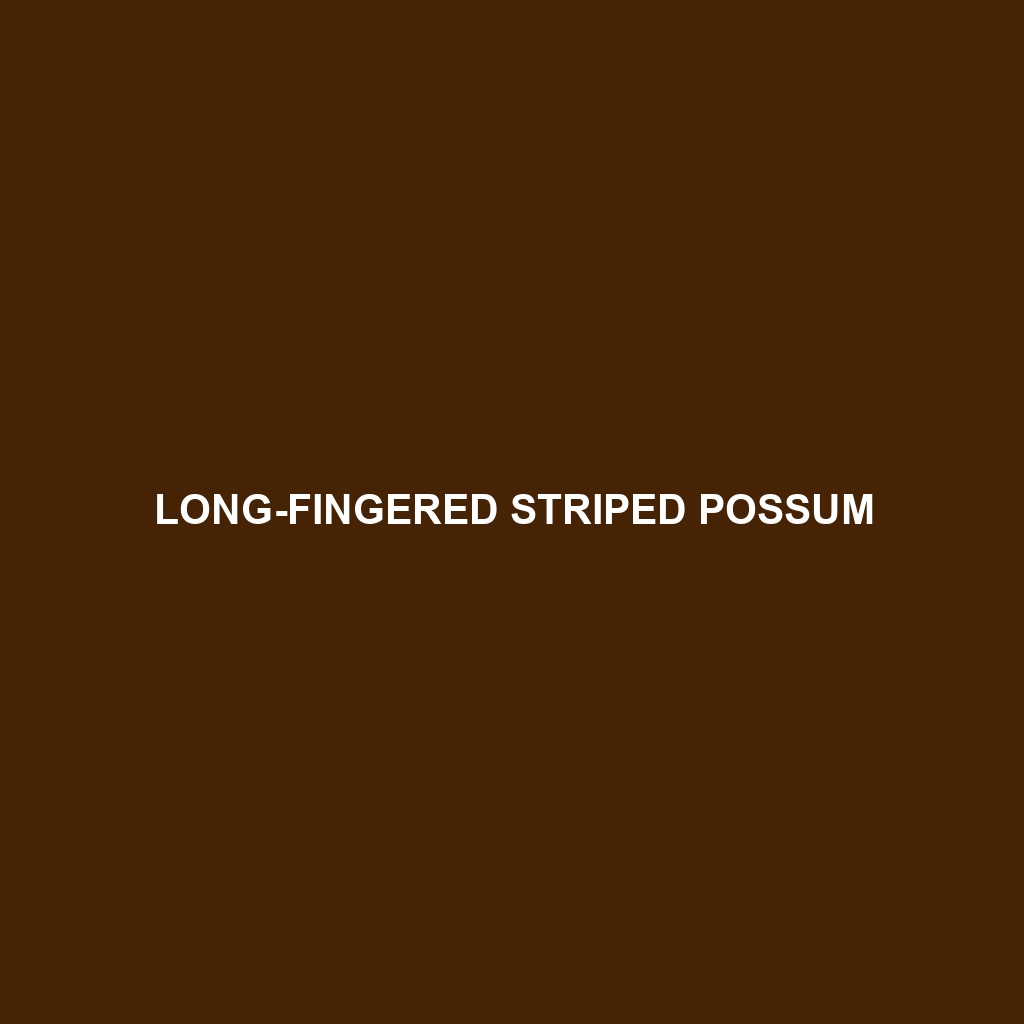Long-fingered Striped Possum: A Detailed Overview
The Long-fingered Striped Possum (Dactylopsila trivirgata) is a unique and fascinating marsupial native to the forests of New Guinea and northern Australia. Known for its striking black and white striped fur and elongated fourth finger, this nocturnal mammal is adept at foraging for insects and grubs hidden within tree bark. Its distinctive appearance and specialized feeding habits make it an intriguing species for researchers and wildlife enthusiasts alike.
Physical Characteristics
Size: The Long-fingered Striped Possum typically measures between 25 to 30 centimeters (10 to 12 inches) in body length, with a tail that adds an additional 30 to 35 centimeters (12 to 14 inches). It weighs around 200 to 250 grams (7 to 9 ounces).
Coloration: This possum is easily recognized by its striking black and white coloration. It has a predominantly black body with three prominent white stripes running longitudinally along its back. Its face is marked with contrasting white patterns around the eyes and muzzle.
Special Features: The most notable feature of the Long-fingered Striped Possum is its elongated fourth finger, which is significantly longer and thinner than its other digits. This adaptation is specifically evolved to help the possum extract insects and larvae from tree bark and other crevices.
Behaviors
Social Interactions: The Long-fingered Striped Possum is generally solitary, although it may occasionally be found in pairs or small family groups. It communicates through a range of vocalizations, such as clicks and chirps, to establish territory and interact with potential mates.
Feeding Habits: This species is primarily insectivorous, specializing in feeding on wood-boring insects and larvae. It uses its elongated finger to tap on wood surfaces, listening for hollow areas where insects might be hiding. Once located, the possum uses its sharp teeth and elongated finger to extract its prey. It also consumes fruits, nectar, and occasionally small vertebrates to supplement its diet.
Ecological Roles: As an insectivore, the Long-fingered Striped Possum plays a crucial role in controlling insect populations within its habitat. Its foraging behavior helps to reduce infestations of wood-boring insects, which can be detrimental to tree health.
Habitats
Natural Environment: The Long-fingered Striped Possum inhabits tropical and subtropical rainforests, preferring dense, humid environments with abundant tree cover. It is typically found at elevations ranging from sea level to around 1,500 meters (4,920 feet).
Range: This species is found in New Guinea and the Cape York Peninsula in northern Australia. It occupies both primary and secondary forests and can sometimes be found in forested areas near human settlements.
Adaptations
Elongated Finger: The possum’s most notable adaptation is its elongated fourth finger, which is highly specialized for extracting insects from tree bark and other tight spaces.
Nocturnal Lifestyle: Being nocturnal, the Long-fingered Striped Possum has adapted to a life of foraging at night. It has keen senses of hearing and smell to locate prey in the dark.
Climbing Ability: With its strong limbs and prehensile tail, this possum is an excellent climber, able to navigate through the forest canopy with ease.
Conservation Status
The Long-fingered Striped Possum is currently listed as a species of Least Concern by the IUCN Red List, due to its relatively wide distribution and presumed large population. However, habitat loss due to deforestation and land development poses ongoing threats to its environment. Conservation efforts aimed at preserving rainforest habitats are crucial for the long-term survival of this unique species.
Fun Facts
Mimicry of Other Species: The Long-fingered Striped Possum’s black and white coloration is thought to mimic that of the more aggressive skunk, potentially deterring predators.
Unique Foraging Technique: Its method of tapping on wood to locate insects is similar to the foraging behavior of the Aye-Aye, a lemur species from Madagascar, making the Long-fingered Striped Possum an example of convergent evolution.
Variety in Diet: Despite its specialization in insect hunting, this possum has a diverse diet that includes fruits and nectar, showcasing its adaptability in different environments.
The Long-fingered Striped Possum, with its unique adaptations and striking appearance, continues to captivate the interest of those who study and admire the biodiversity of our planet’s rainforests. By understanding and protecting its habitat, we can ensure that this remarkable species thrives for generations to come.
